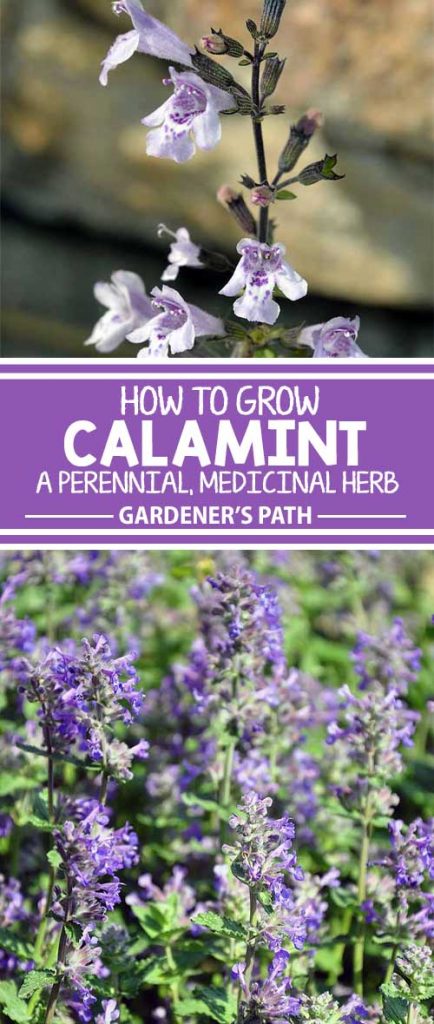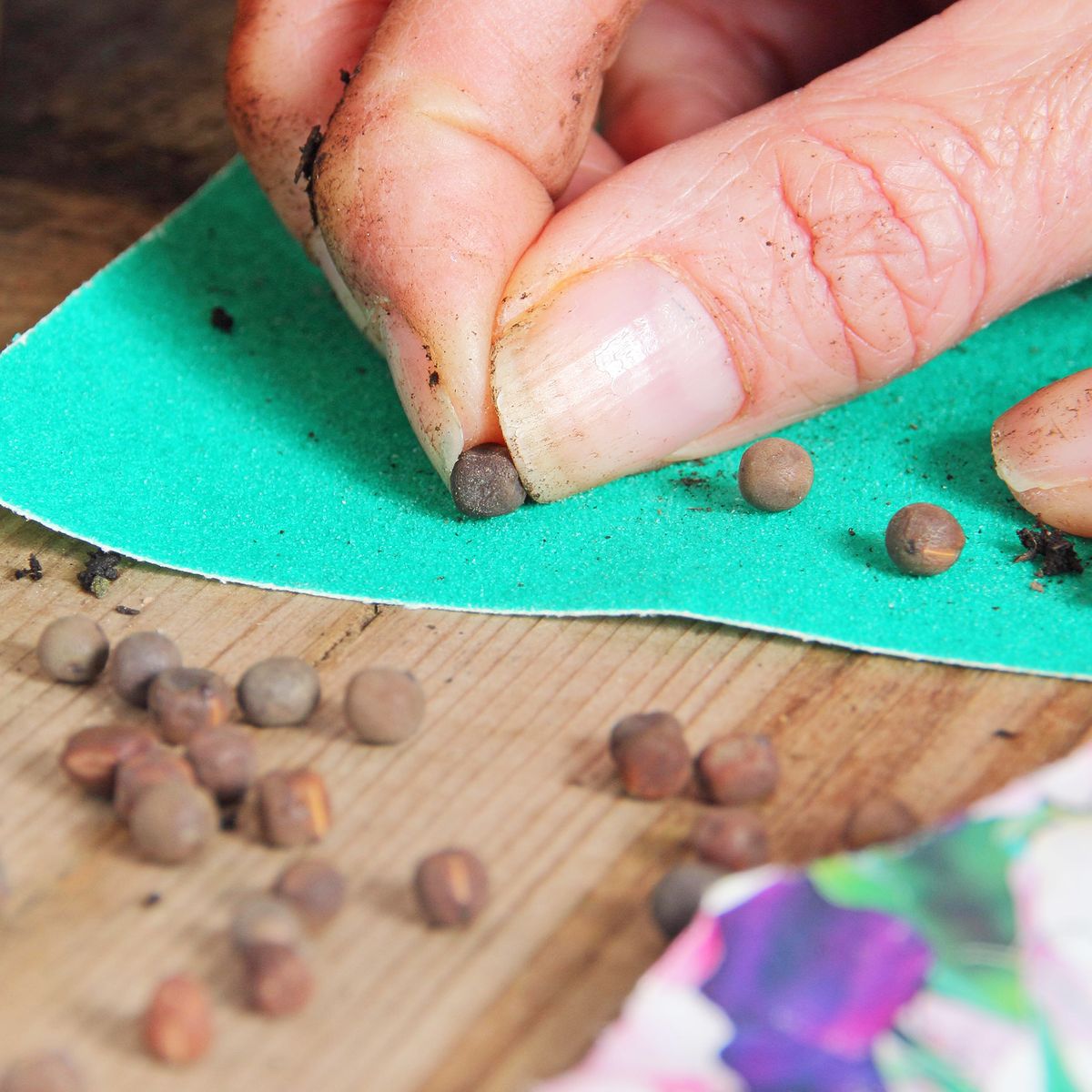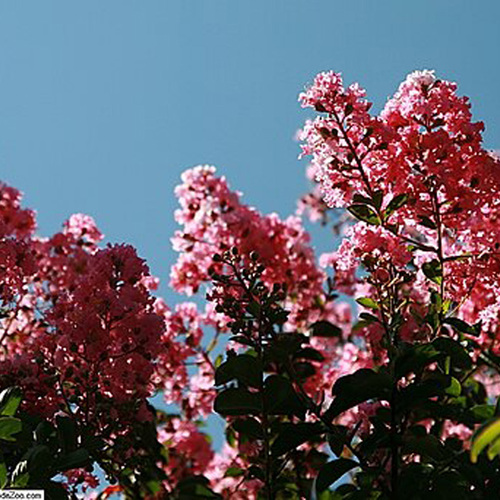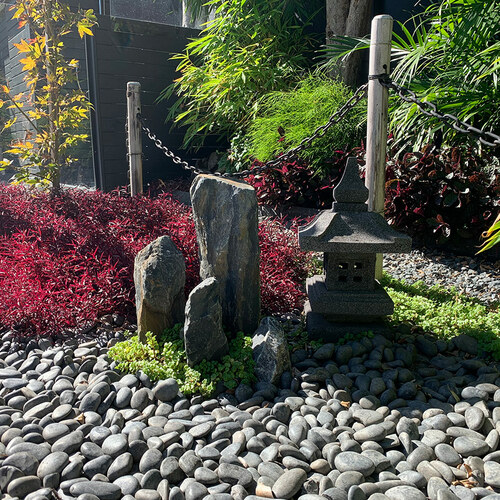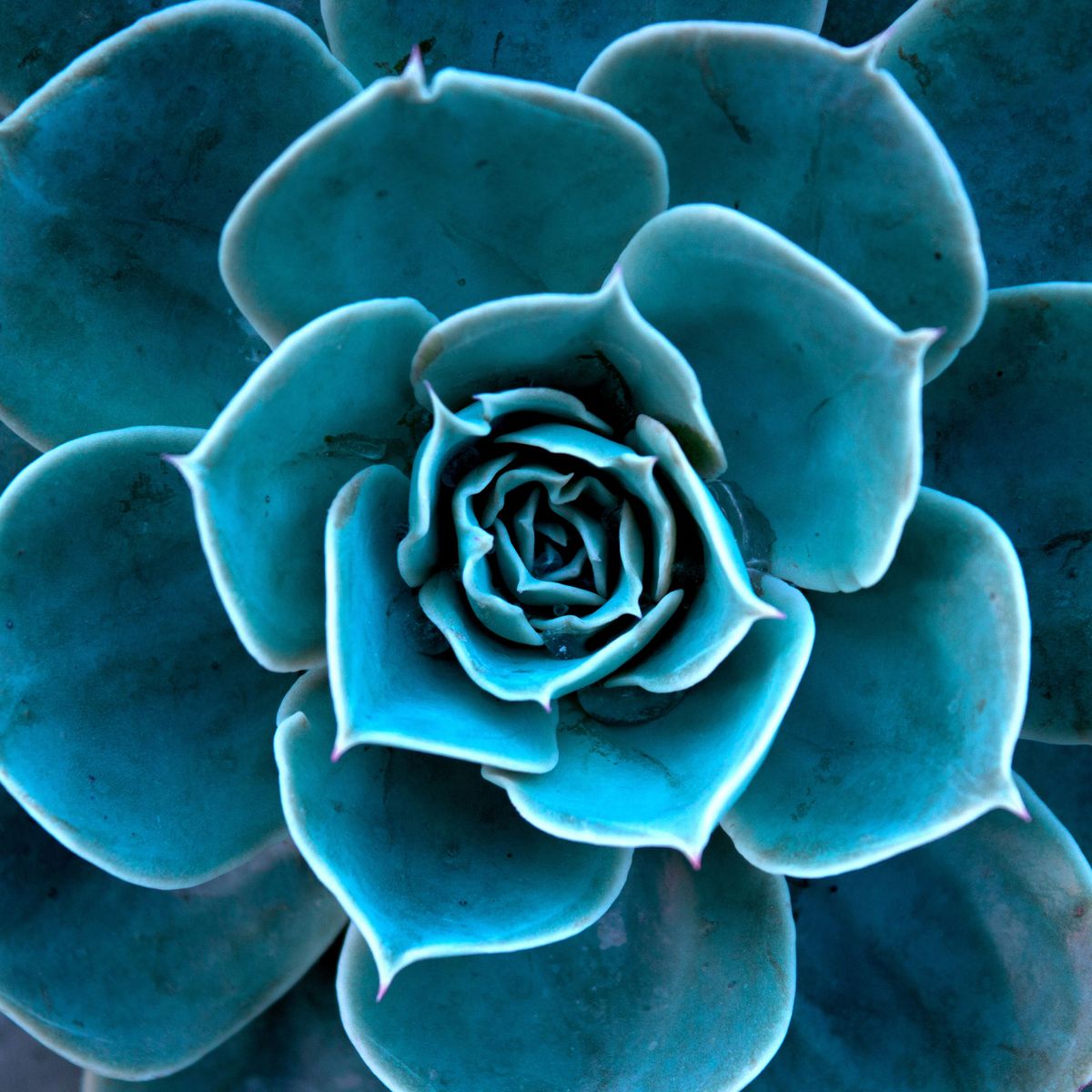Clinopodium spp.
One of the delights of gardening is growing one’s own fresh supply of herbs – including lesser-known aromatics such as calamint!
This hidden gem of an herb adds a surprising flavor to savory dishes and is easy to grow in the garden.

We link to vendors to help you find relevant products. If you buy from one of our links, we may earn a commission.
More common in cultivation in Europe than in America, calamint plants produce profuse and showy, delicate blooms from early summer to autumn, with a number of species and cultivars that make fine additions to the garden.
While there are over 180 different species of calamint, we’ll provide growing and care recommendations for the most common types you’ll be likely to grow in the garden, and we’ll also look at a few other species of interest.
Here’s what we’ll cover:
What Is Calamint?
Calamint (Clinopodium spp.) is a genus of small shrubs and herbaceous perennials known for their fragrant leaves and flowers.
These plants tend to have a dense, mounding, and bushy growth habit, with leaves held opposite on stems.
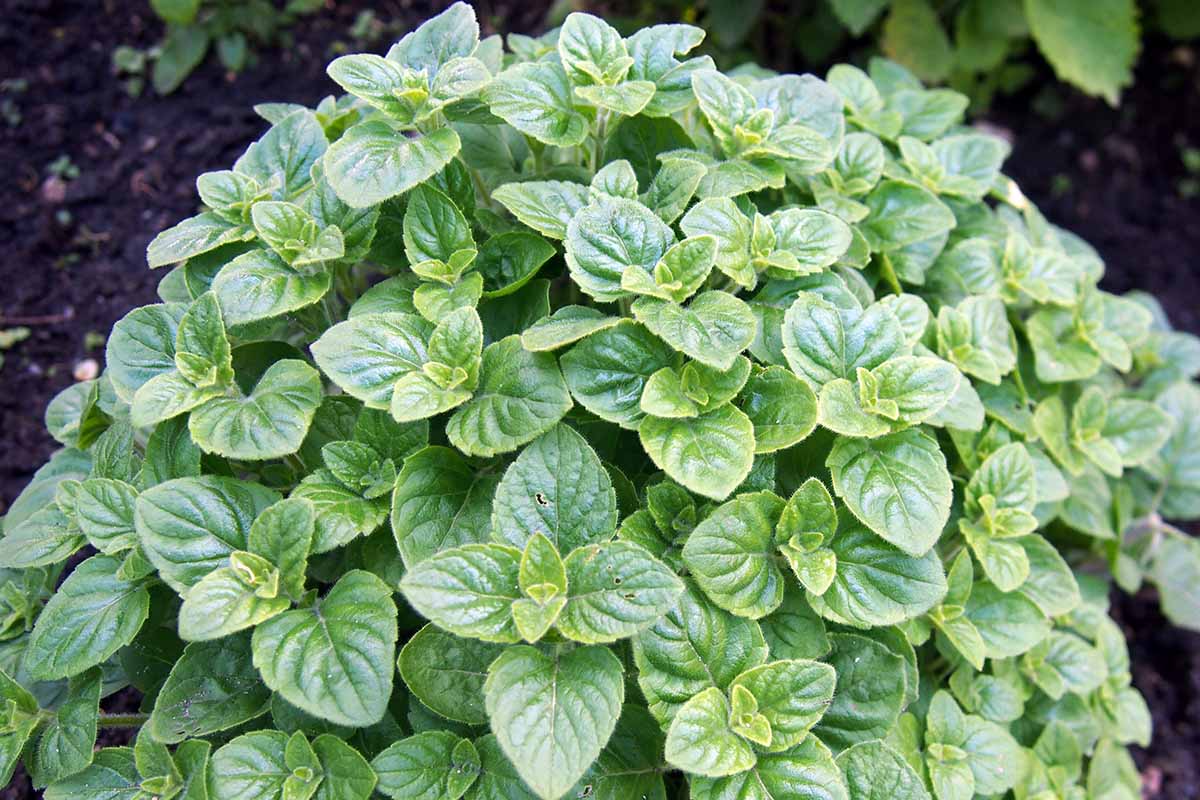
Like mint, the stems of these plants are square when viewed in cross section. Some species have hairy leaves, while others’ leaves are smooth.
They are green to grayish green, and are usually oval shaped with wavy or serrated margins.
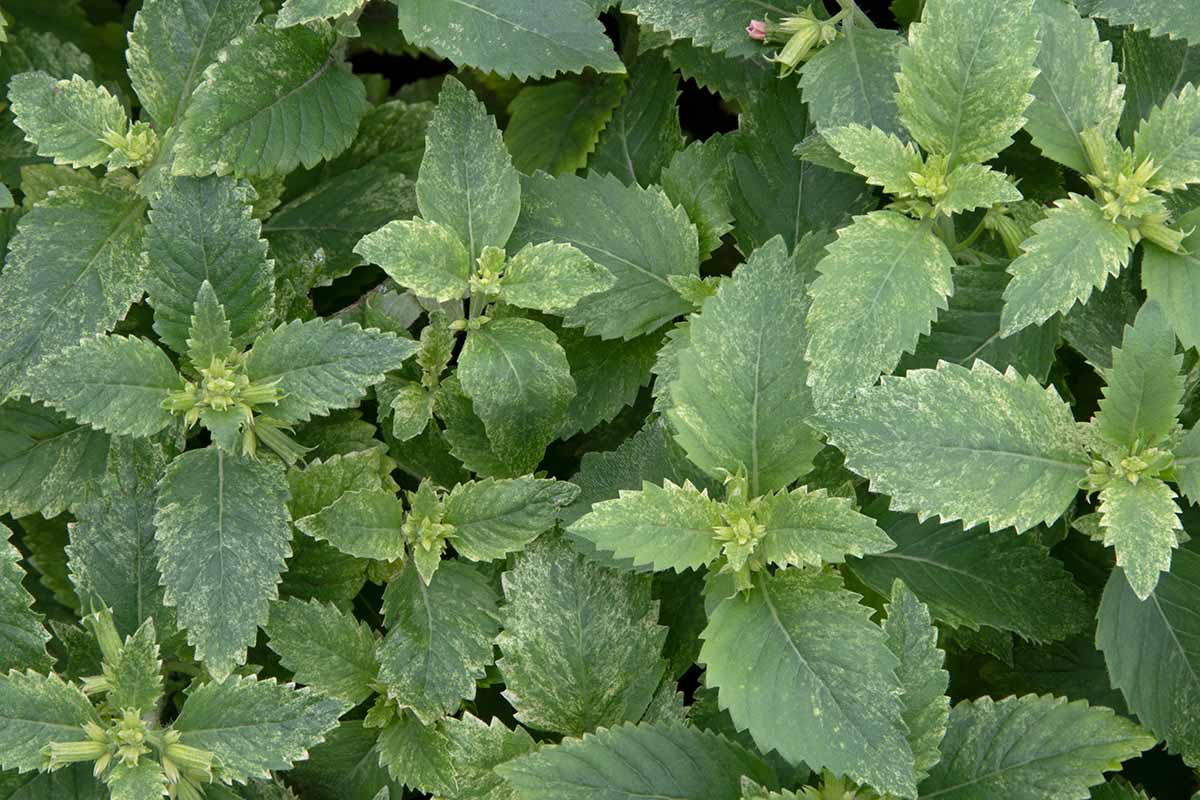
The tubular white, lilac, pink, red, or light blue flowers bloom from summer to autumn, with some even continuing on after light frosts.
The herb’s flowers grow at the leaf axils, and with some species and cultivars, the entire plant seems to be covered with blooms.
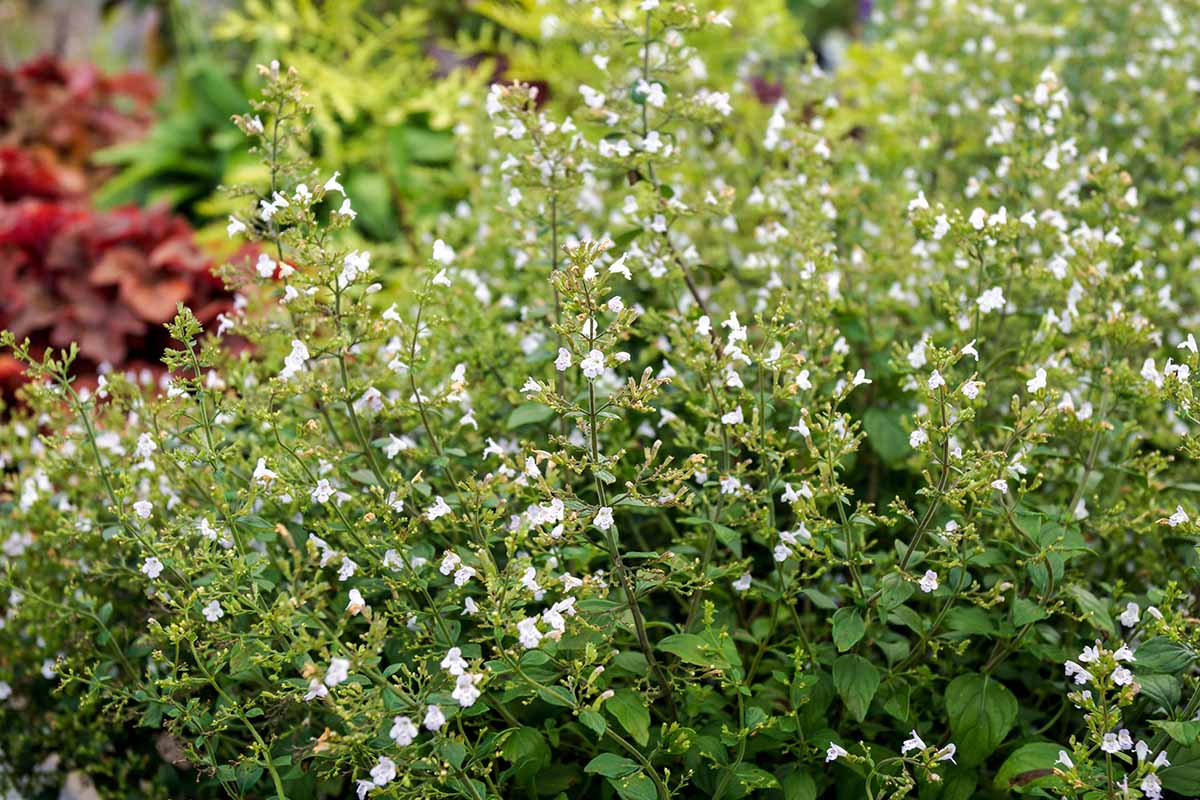
To set the record straight, we’re not talking about catmint here – or about catnip.
Just as the two herbs catnip and catmint are often confused, the subject of our article is sometimes confused with catmint, and understandably so!
There are similarities between these herbs.
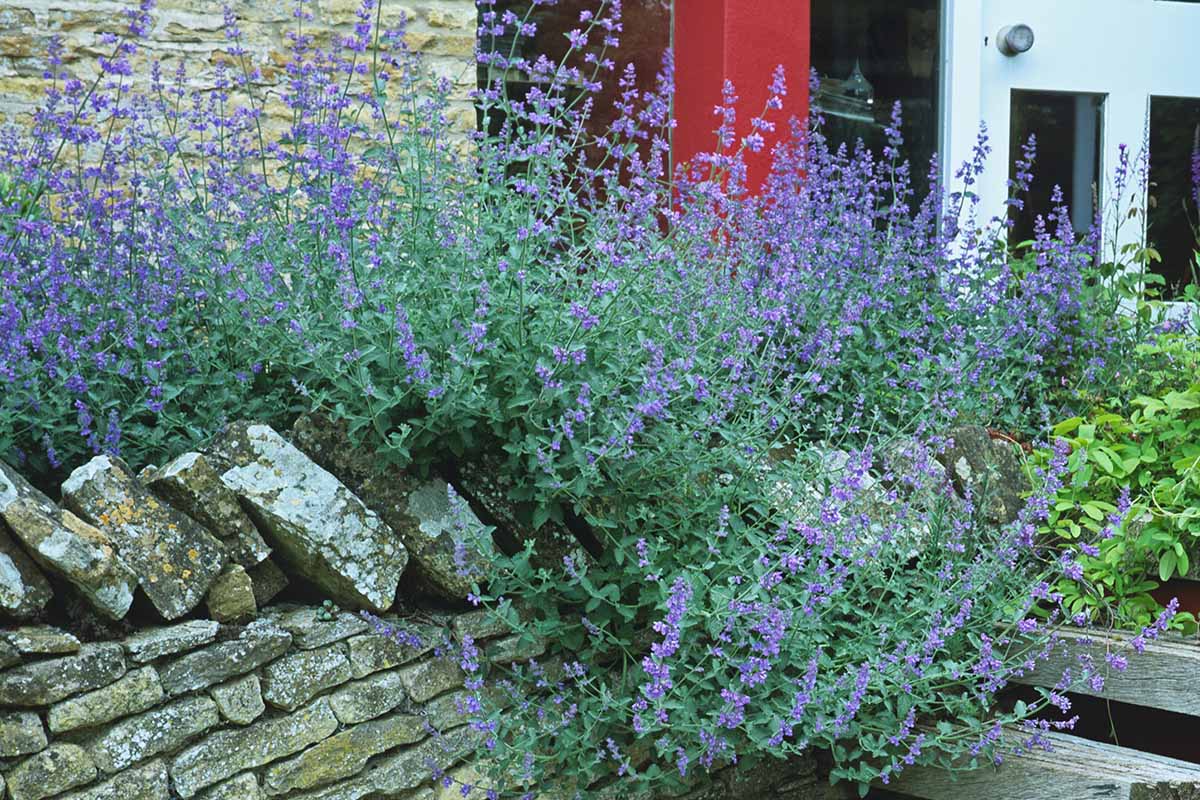
However, while calamint tends to produce flowers along stems of the plant, nestled among its leaves, that other herb, catmint, tends to have spikes of flowers held mostly above the foliage.
Were you looking for catmint instead? Read all about catmint in our article!
Cultivation and History
The genus Clinopodium is spread across a wide geographic range, growing in temperate to tropical regions across the world in locations that include Africa, Asia, Europe, North America, and South America.
Formerly classified botanically as Calamintha, the Clinopodium genus includes 186 different species of plants.
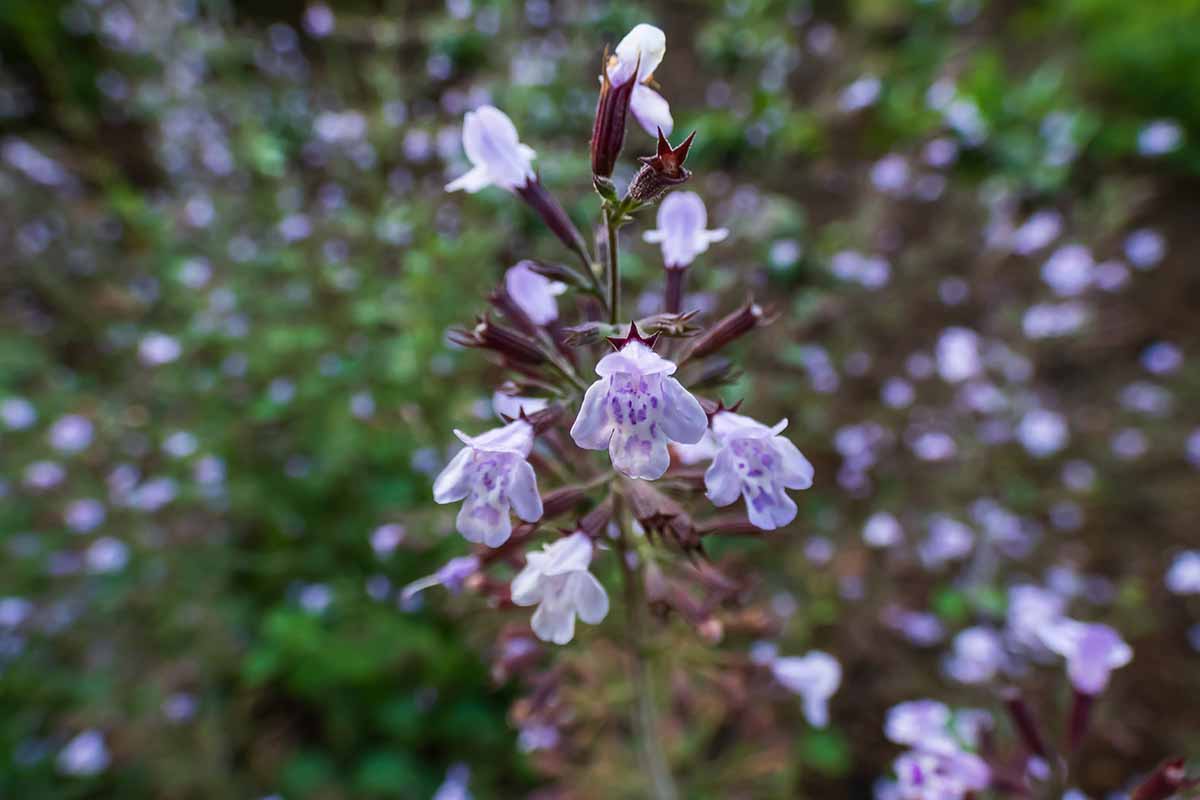
These herbaceous perennials and small shrubs. are members of the mint family or Lamiaceae, just like spearmint, savory, coleus, and bee balm.
The word “calamint” traces its origins back to the Greek “kalaminthe,” meaning either “odiferous plant” or “beautiful mint.”
References to the herb appear in English language medicinal texts from the 1500s in which the healing attributes of the plant were lauded.
In “Culpeper’s Complete Herbal,” published in 1826 and available via Amazon, English botanist and herbalist Nicholas Culpeper describes calamint (though he doesn’t indicate which species) as a diuretic and antiparasitic as well as a cure for those with shortness of breath or an “old cough.”
Modern investigations into these plants’ medicinal properties show that essential oils of the herb C. nepeta are antioxidant, antimicrobial, and anti-inflammatory.
In addition to its potential medicinal uses, calamint leaves can be used culinarily – and its flowers are edible as well!
We’ll dive in to the plant’s culinary uses later in the article, so keep reading.
Whether you’re growing this herb for its potential medicinal properties, as a culinary spice, or to brighten up your garden, the recommended USDA Hardiness Zone will vary depending on the species.
The two most commonly grown garden calamints are hardy in Zones 5 to 7, for lesser calamint, and Zone 5 to 9, for showy calamint.
In many locations, gardeners can count these plants among the cold-hardy herbs that can survive winter!
Note that some of these species may escape cultivation and be considered as weeds, naturalized species, or invasives depending on the location.
Check your state’s invasive species list to find out if this is a concern in your area.
Propagation
Calamint is an herb that can be propagated from seeds, cuttings, or via division. Let’s look at all three methods as well as how to transplant potted plants – we’ll start with growing from seed.
From Seed
Growing calamint is an early spring project – sow these herb seeds around eight weeks before your average last frost.
In addition to seeds and two- or four-inch nursery pots, you’ll need a seed-starting medium, such as Organic Mechanics Seed Starting Blend.

Organic Mechanic’s Seed Starting Blend
You can find Organic Mechanic’s Seed Starting Blend in an eight-quart bag, available to purchase via Amazon.
Once you have gathered your supplies, fill the nursery pots with growing medium, leaving about an inch of space between the top of the soil and the rim of the pot.
Next, take two or three seeds – these are quite small so handle with care! – and scatter them on the surface of the growing medium, pressing them into the soil lightly.
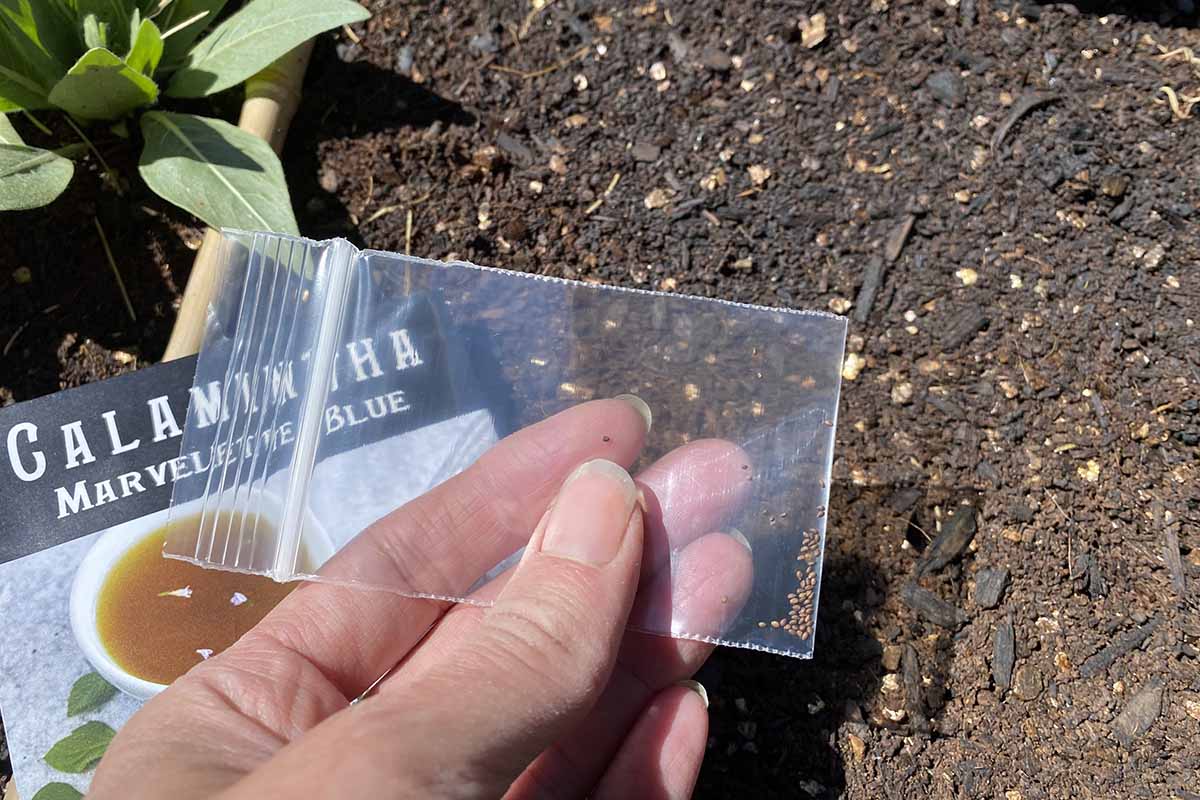
Water gently and place the nursery pots in bright, direct light.
While awaiting germination, keep the soil evenly moist. Germination should occur within one to three weeks.

Growing calamint from seed is much like growing mint since these herbs are part of the same family. For more guidance, be sure to review our tips for growing mint from seed!
From Cuttings
Calamint can be propagated by rooting cuttings from a mature plant during spring or summer.
Use a sterilized pair of scissors or garden pruners to take a cutting with four or five pairs of leaves.
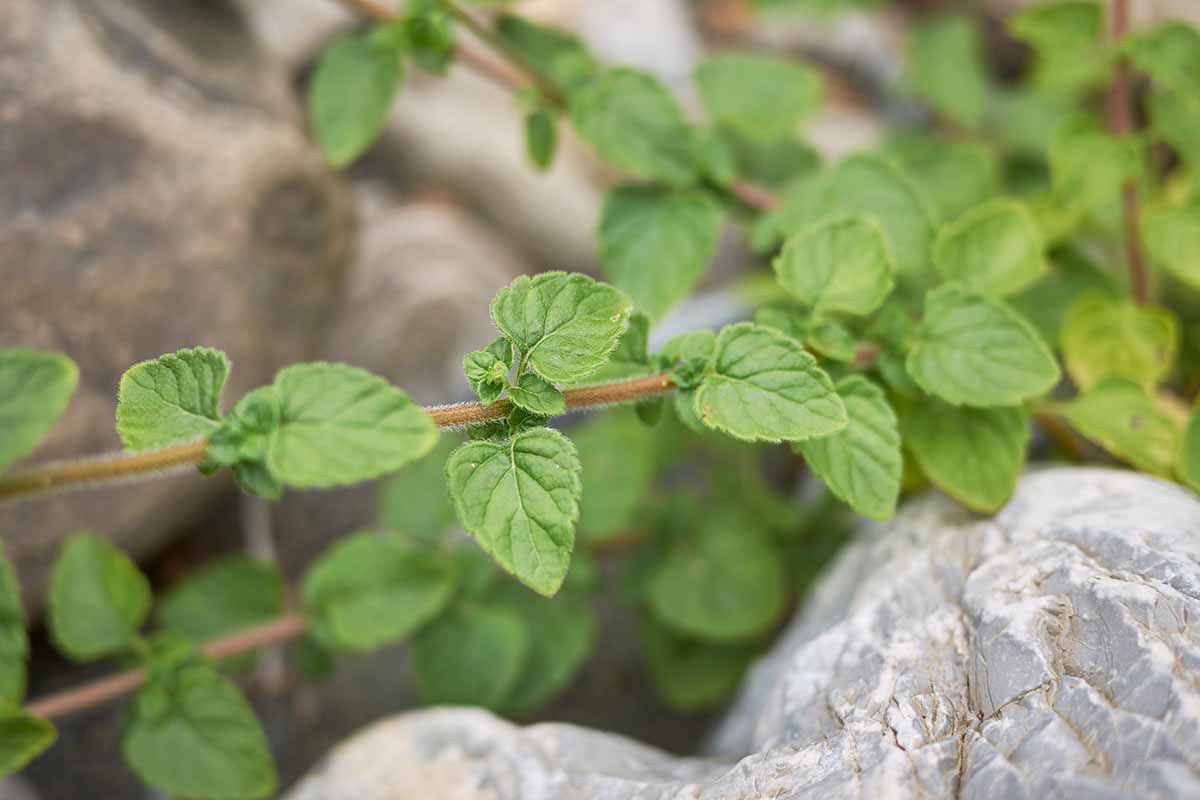
Prepare a four-inch nursery pot by filling it with growing medium to within an inch of the rim.
Use a pencil, a chopstick, or your finger to poke a hole in the center of the pot.
Remove the bottom three pairs of leaves from the herb cutting, then dip the base of the cutting into rooting hormone.
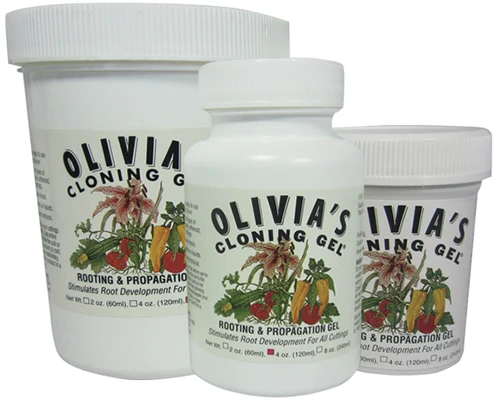
Olivia’s Cloning Gel
Do you need some rooting hormone? You’ll find Olivia’s Cloning Gel in two-, four-, or eight-ounce bottles via Arbico Organics.
Next, stick the cutting into the hole, then press the growing medium gently down and around it so the cutting is secure.
Place the potted cutting in a shady location, and water it in.
Keep the soil moist. The cutting should root within three to four weeks. Gradually transition the rooted cutting into full sun.
If you’re rooting cuttings indoors or in a greenhouse, harden them off before planting them outdoors in the garden.
To harden off new plants, place them outside in a shady, protected location for a couple of hours. Over the next several days, gradually increase the plant’s exposure to sun and wind while increasing the amount of time outdoors.
A cold frame can also be used during this process.
Finally, position the calamint plants in their intended location in your garden for a day or two before planting to reduce the risk of transplant shock.
From Division
Gardeners can also propagate Clinopodium species via division in spring or fall.
Wait until the plant has gotten established before attempting division – you may even wish to wait until it is growing larger than its allotted space in your landscaping.
When you’re ready to divide, grab a shovel and cut out a section of the plant, making sure to take some rhizomes with your division.
Then replant the new specimen directly into a pre-dug hole, or situate it temporarily in a nursery pot.
Need further instructions? Read our article for a complete guide to dividing perennials!
From Transplants
Once you have a potted calamint plant that you have either grown yourself or purchased from a nursery, you’ll want to plant it in the ground – unless of course you prefer to grow it in a pot permanently.
If that’s the case, be sure to read our article on growing herbs in containers.
On the other hand, for herb specimens destined for life lived at ground level, the transplanting process is pretty straightforward.
After the plant has been hardened off (if necessary), gardeners should prepare the growing area by removing any weeds from the soil.
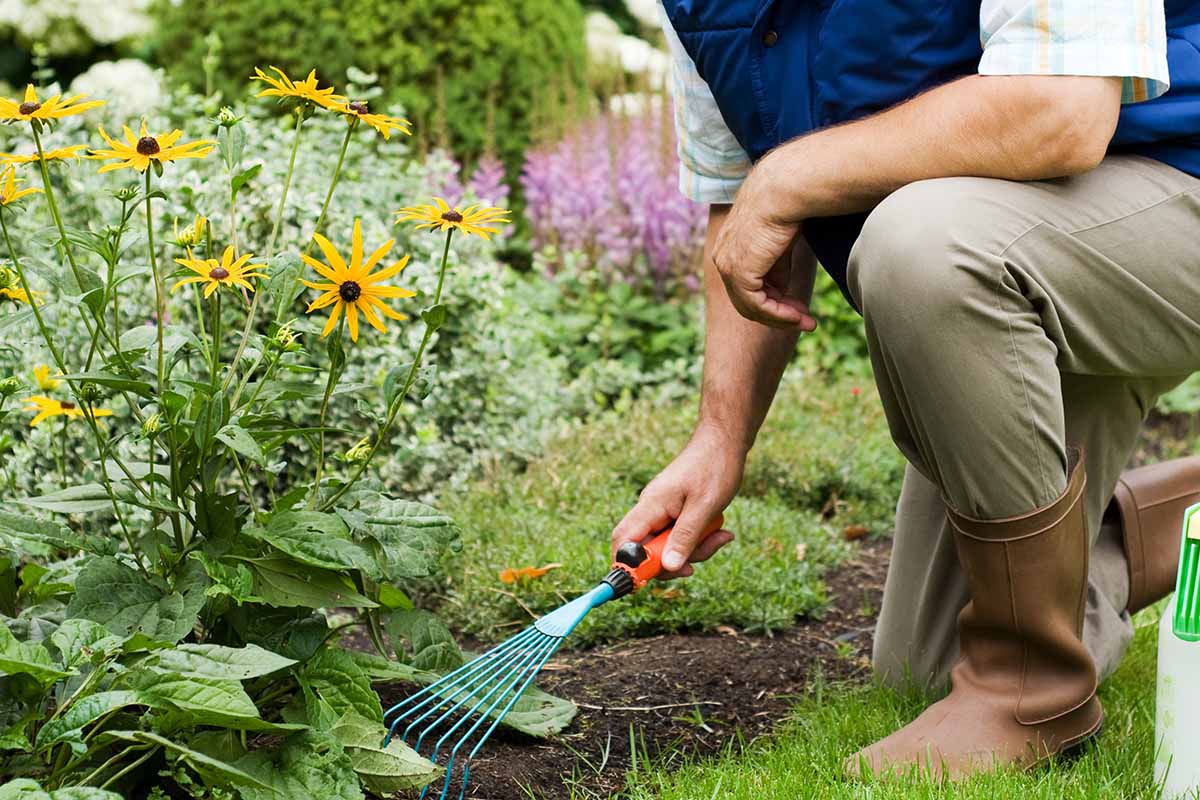
Use a shovel, trowel, or hori hori to dig a hole twice as wide as the nursery pot and a couple of inches deeper.
Depending on the species of Clinopodium you’ll be growing, you may want to add a handful of well-rotted compost to the hole as an amendment.
Remove the plant from the nursery pot, taking care not to pull it out by its foliage – instead, squeeze the sides of the pot, tilt it down, and ease the root ball out of the pot.
Rough up the herb’s roots by rubbing your hand along them – particularly if the plant is root bound.
If any growing medium is released from the roots of the plant, put it in the hole. Now add some of the soil you removed from the hole and mix it with the compost and growing medium.
Situate the plant in the hole so that the top of the root ball is level with the ground, removing or adding soil beneath the root ball as needed.
Once the herb is at the right level, backfill with the removed soil, then press gently around the plant so the hole is well filled with soil but not compressed. Water in well.
Keep the soil moist as your transplant gets established – it may need to be irrigated if your location lacks regular rainfall.
How to Grow
Most species of calamint you’re likely to grow at home will perform well in your garden, yard, or landscaping when located in full sun.
However, if full sun is like a blast furnace in your location, these plants will be happy to receive some afternoon shade.
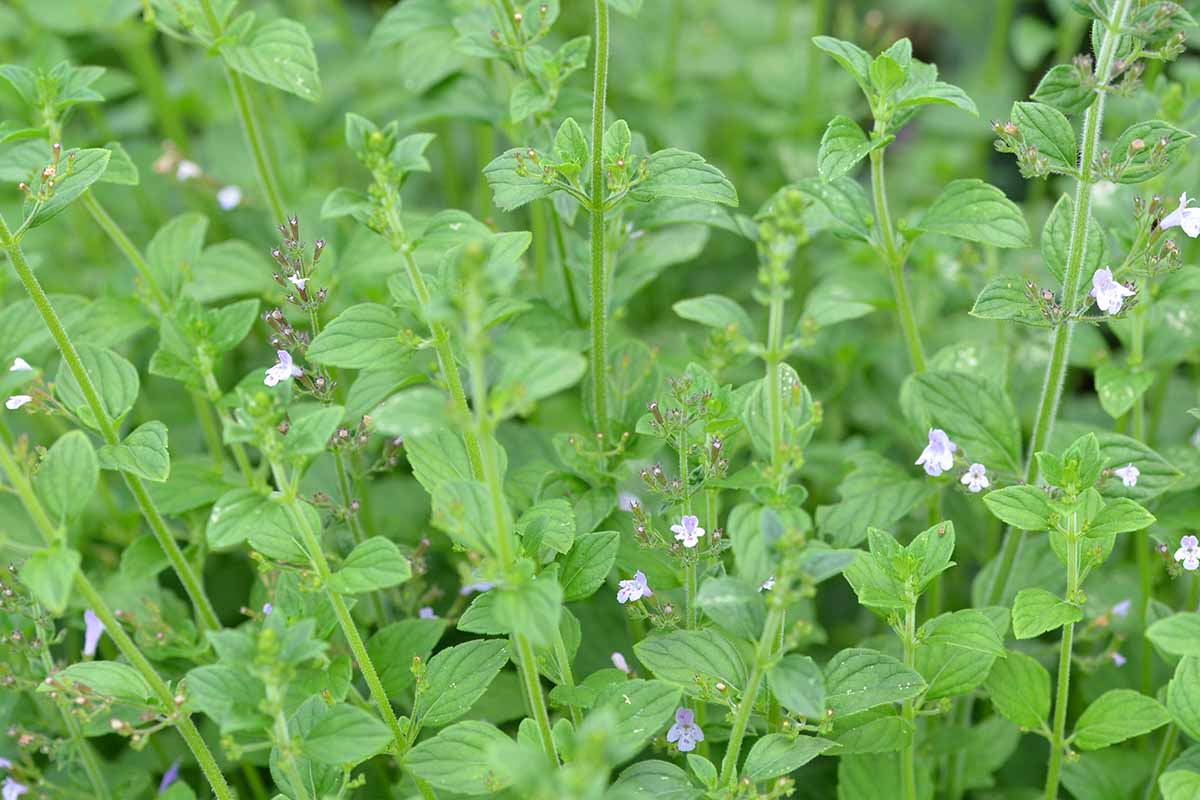
These tough herbs tend to do well in sandy, loamy, rocky, or shallow well-drained soils – as well as average type garden soil. Depending on the species, plants will thrive in acidic or neutral soils and may even grow in very alkaline soils.
Your plant may require more frequent watering for the first month or so after planting depending on the weather in your location.
After this initial honeymoon period in which you pamper your calamint, provide the plant with infrequent but deep soaks for the first year – unless of course you receive plenty of rainfall. In that case, let the clouds do the work for you!
Once established in the garden, calamint has some drought tolerance, though it’s best to not let the soil go bone dry.
Growing Tips
- Grow in full sun, or provide afternoon shade in hot locations.
- Locate in well-drained soil.
- Provide irrigation as needed until established and during heat waves.
Pruning and Maintenance
Calamints require little maintenance, especially if you choose the right type for your growing conditions. You’ll learn about several different species of this herb in the next section, so keep reading!
Many species of Clinopodium will form their own ground cover as they mature, but while plants get established, make sure to weed around them to prevent weeds from overpowering these herbs.
Place mulch around the plants to discourage weed growth, prevent moisture loss, and regulate soil temperature. Mulch should be applied in a layer two to four inches thick, but take care not to bury the stems in mulch.
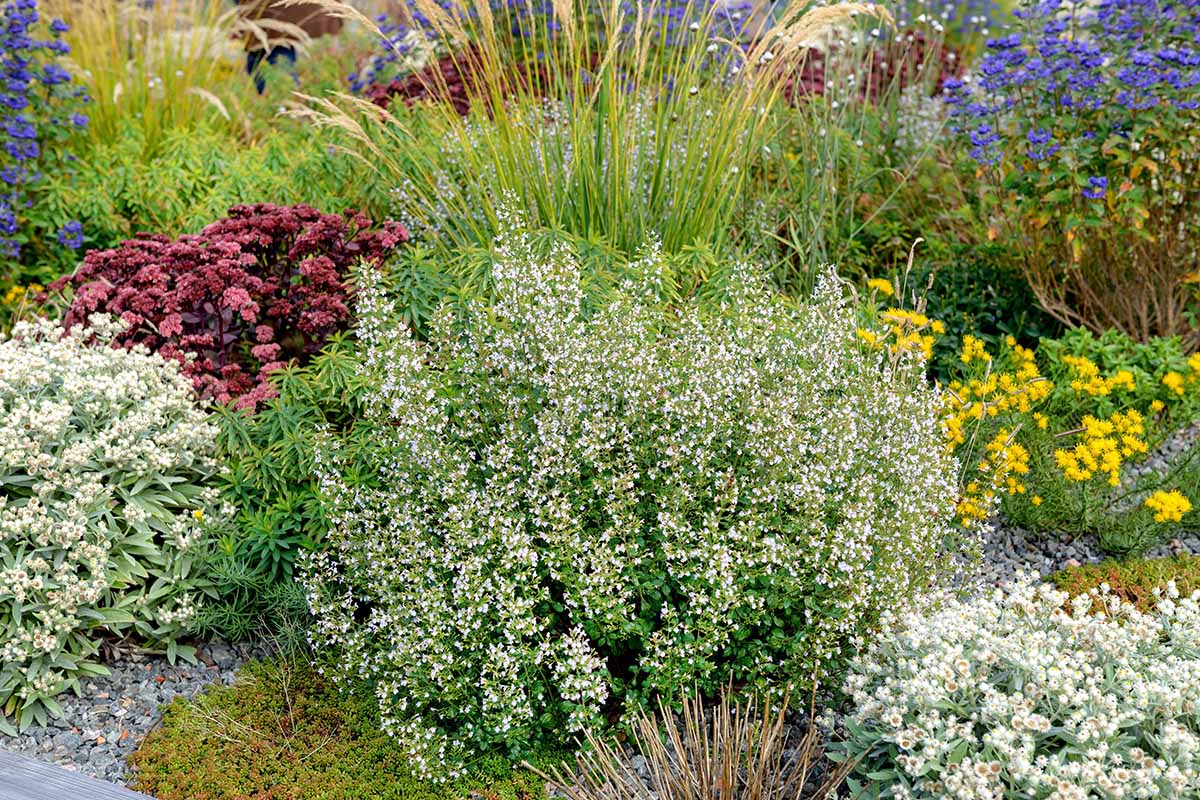
Not sure what to use? Read our article on mulching for low maintenance gardening to choose the best option for your garden!
As for fertilizer, many types of calamint will do just fine without it – particularly native types grown in their natural ranges.
For gardeners who are willing to put in the extra effort to encourage loads of blooms, applying a handful of compost to the soil every few weeks during the growing season will do the job.
When applying compost in this way, scoot mulch away from plants, rake compost into the soil, water in, and replace the layer of mulch.
Some species of calamint may not need pruning. Those most commonly grown in the garden can be cut back to six inches tall in the springtime to keep plants looking tidy.
Species and Cultivars to Select
As this plant is relatively unknown in the United States, sourcing both seeds and transplants isn’t as easy as with some of the more popular garden herbs, like basil and thyme.
When seeking out calamint seeds and live plants, your best bet might be to barter seeds or request a cutting from a fellow gardener.
You may also find seeds from vendors that specialize in heirlooms or unusual plants, specifically herbs.
Here are some of the species and cultivars of this herb that you may want to consider for your garden:
C. Coccineum
Let’s start with an unexpected option – one with scarlet-colored blooms!
If you’re a gardener who favors native plants and are located in the Gulf Coast region of the US, scarlet calamint (C. coccineum) is a species you’ll want to know about.
Its common names abound. Also known as “red basil,” “red mint shrub,” “red savory,” “scarlet balm,” “scarlet wild basil,” and “southern calamint,” this small shrub is aromatic, sporting bright red flowers on wiry stems.
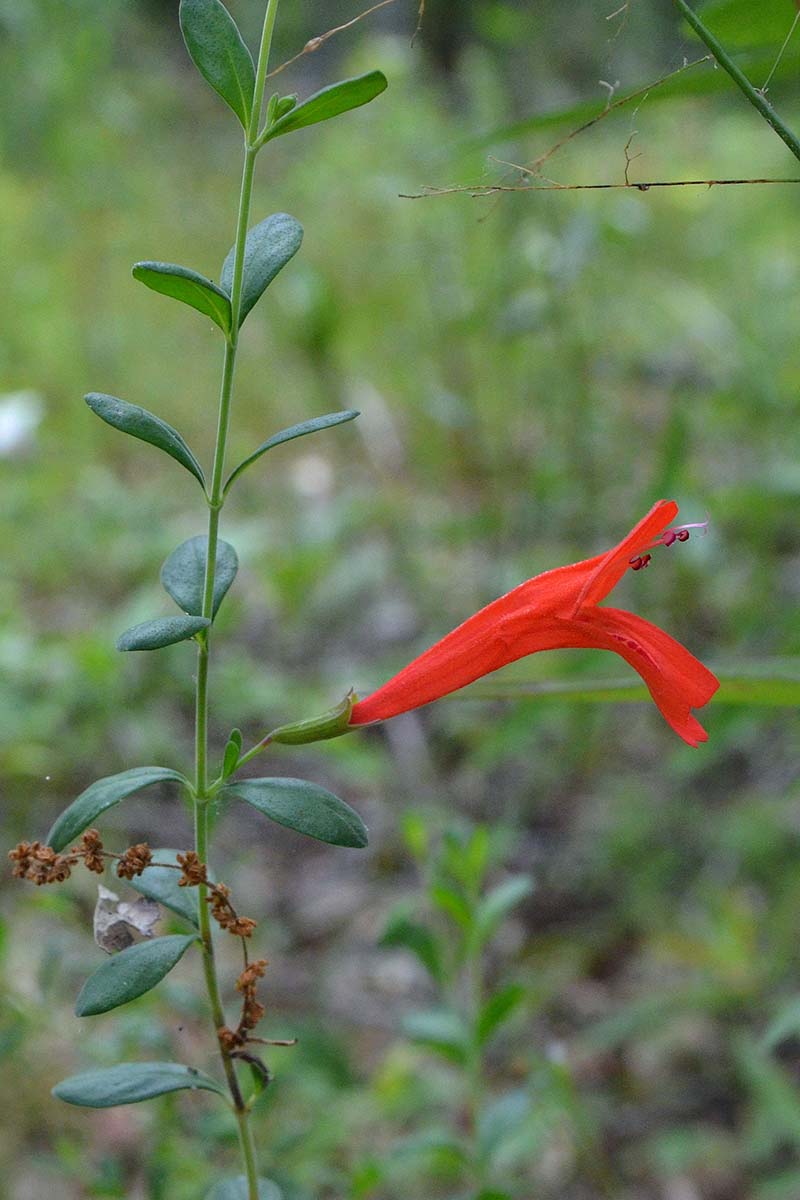
Scarlet wild basil is native to sandy coastal regions of Alabama, Florida, Georgia, and Mississippi, and it grows to be one to four feet tall with a spread of one to three feet.
This plant grows best in sandy, somewhat acidic soils and thrives in full sun to part shade with somewhat moist to dry conditions. It can be grown as a perennial in USDA Hardiness Zones 7 to 9.
With its bright red tubular blooms, this native wildflower is a hit not only with gardeners but also with hummingbirds, as well as butterflies and bees.
C. Grandiflora
Attractive, relatively large, pink to purple flowers have earned C. grandiflora the nickname “large-flowered calamint.”
Also called “showy savory” and “showy calamint,” this species can reach 12 to 18 inches tall and 18 to 24 inches wide. It’s native to Central Europe, the Mediterranean, and Iran.
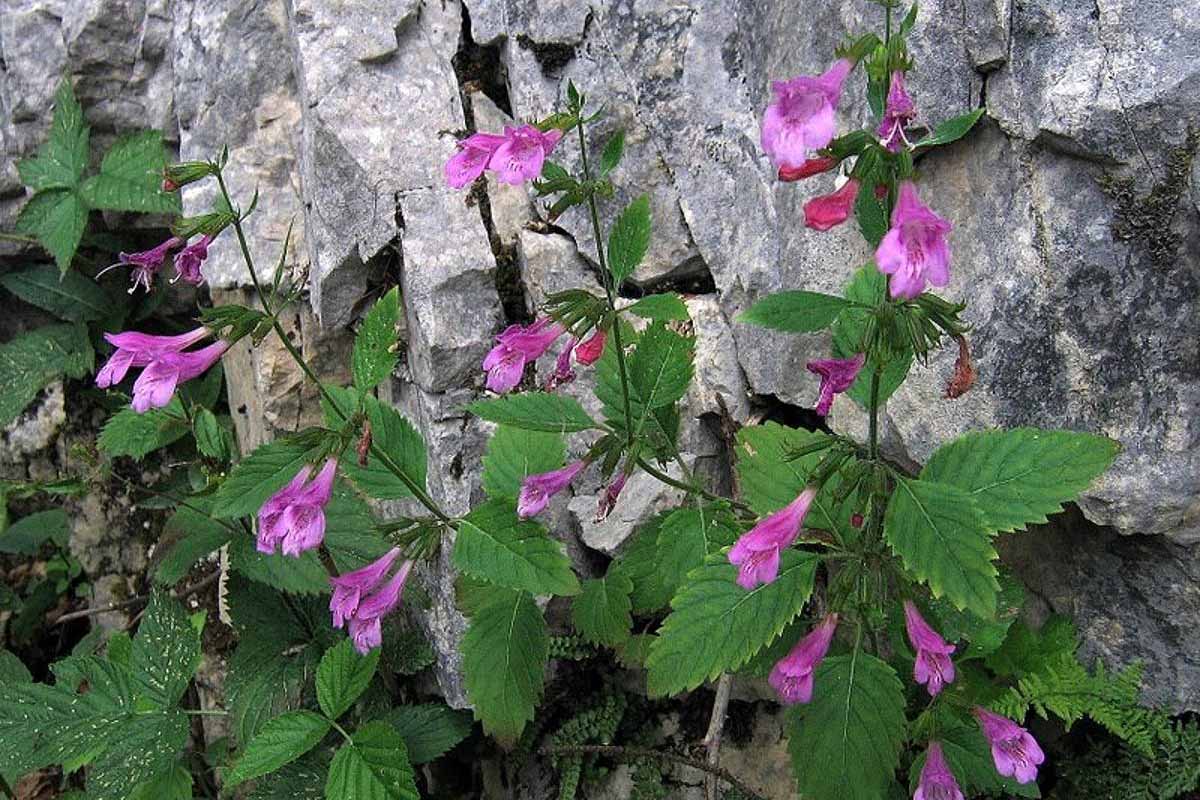
Perfect for the garden, the blooms on this herb species are fairly large for a Clinopodium, reaching one to two inches long.
Large-flowered calamint thrives as a perennial in USDA Hardiness Zones 5 to 9, in full sun to part shade. It requires good drainage, and can grow in a wide range of soils.
Variegata
There is also a variegated cultivar of C. grandiflora which will look equally charming in the garden.

‘Variegata’ has the same larger blooms as the straight species, but this cultivar has lovely green and white mottled foliage.
C. Nepeta
Probably the most well-known of the calamints among gardeners, C. nepeta is commonly called “lesser calamint.”
Plants reach 12 to 18 inches tall and wide and have a bushy growth habit, with small leaves and blooms that impart a delicate texture.
This species has grayish-green leaves, tiny flowers that are white, lilac, or light blue, and a fragrance gardeners liken to a mix between mint and oregano or marjoram.
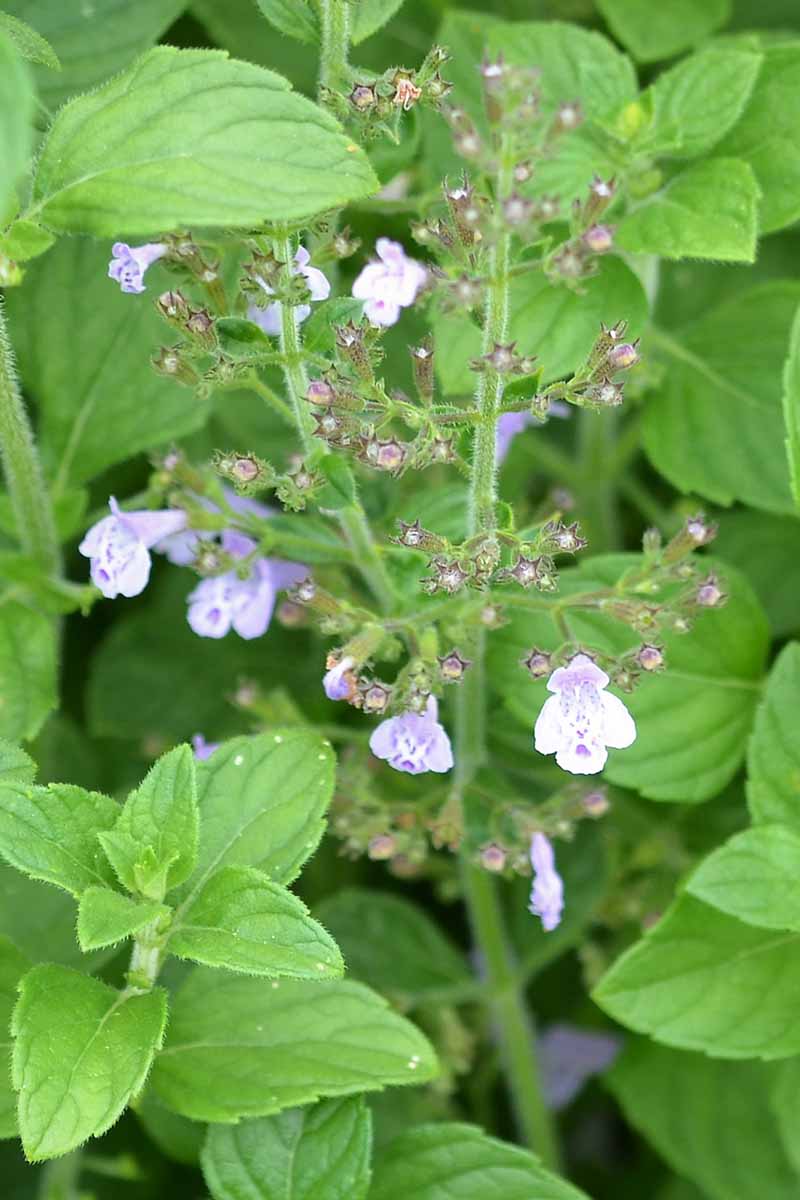
Also known as “mentuccia,” “neputedda,” “nepetella” or “nepitella,” this herb is native to Central Europe, the Mediterranean region, and Northern Iran, and flourishes as a perennial in USDA Hardiness Zones 5 to 7.
Many gardeners the find petite flowers and dainty foliage of C. nepeta to be a delightful border softener.
This species grows well in full sun, thrives in well-draining loam, sand, or clay soils, and prefers an alkaline or neutral pH.
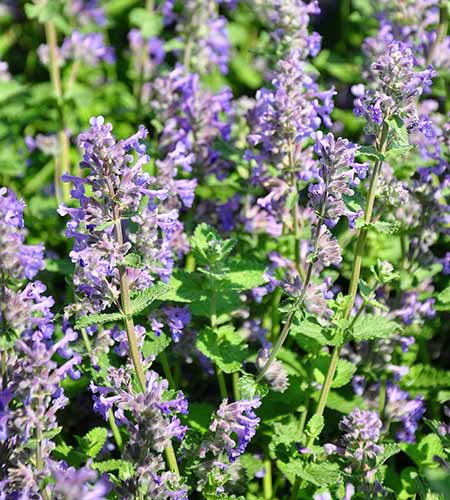
Lesser Calamint Seeds
Ready to grow this fragrant herb yourself from seed? You can purchase packs of 20 lesser calamint seeds from Seedville via Walmart.
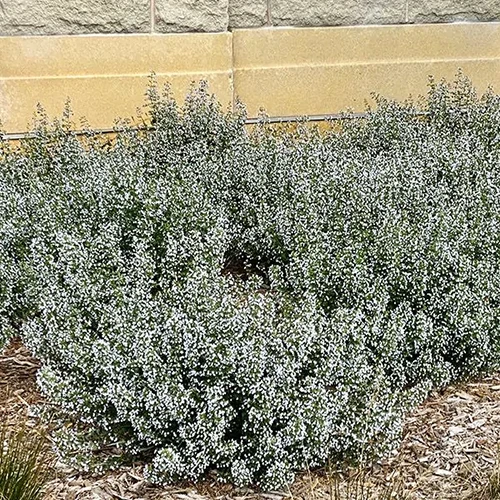
Lesser Calamint Live Plant in 1-Gallon Pot
Or if you’d like the instant gratification of full-grown plants, you’ll find them for purchase in one-gallon pots from Nature Hills Nursery.
In addition to the straight species, there are several cultivars of C. nepeta as well. Let’s look at a few options:
Marvelette Blue
‘Marvelette Blue’ has bluish-lavender flowers that are larger than those of the straight species.
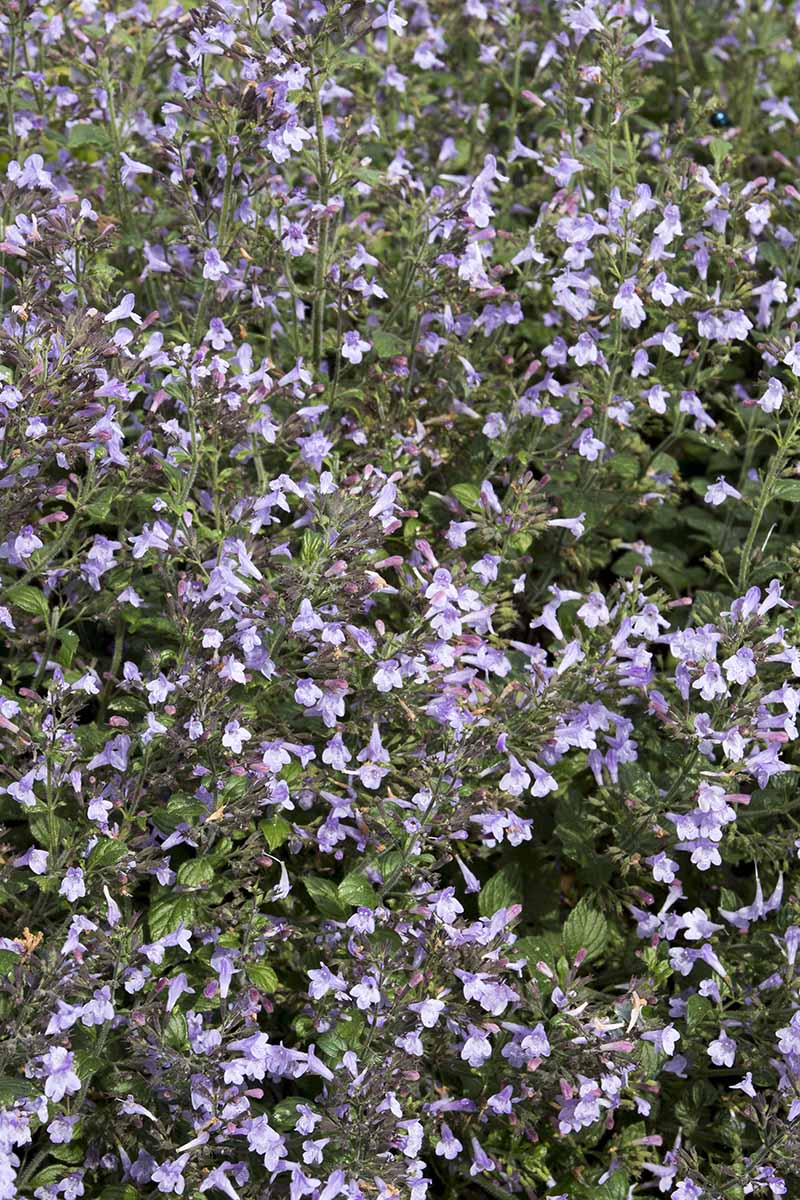
This cultivar is compact, reaching six to eight inches tall and 10 inches wide. Its stems stand upright and bear medium green leaves.
‘Marvelette Blue’ was a Fleuroselect Gold Medal winner in 2016.
Marvelette White
Like ‘Marvelette Blue,’ ‘Marvelette White’ is a compact variety of C. nepeta that has bigger blooms.
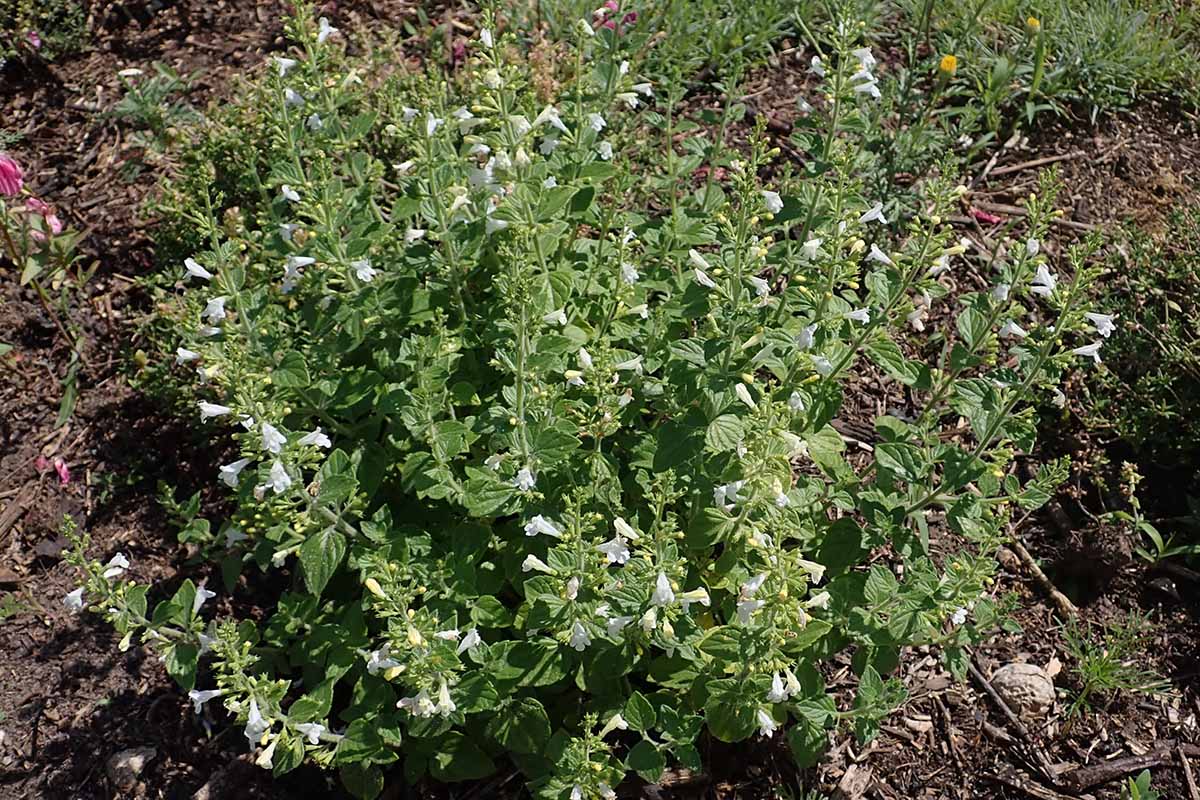
‘Marvelette White’ grows to be just 10 inches tall with a 12-inch spread. Its snow-white blooms arrive earlier than those of the straight species.
Both ‘Marvelette White’ and ‘Marvelette Blue’ can be used to excellent effect as fillers in garden containers.
Nepeta
C. nepeta subsp. nepeta has larger flowers and leaves than the straight species and produces more vigorous plants.
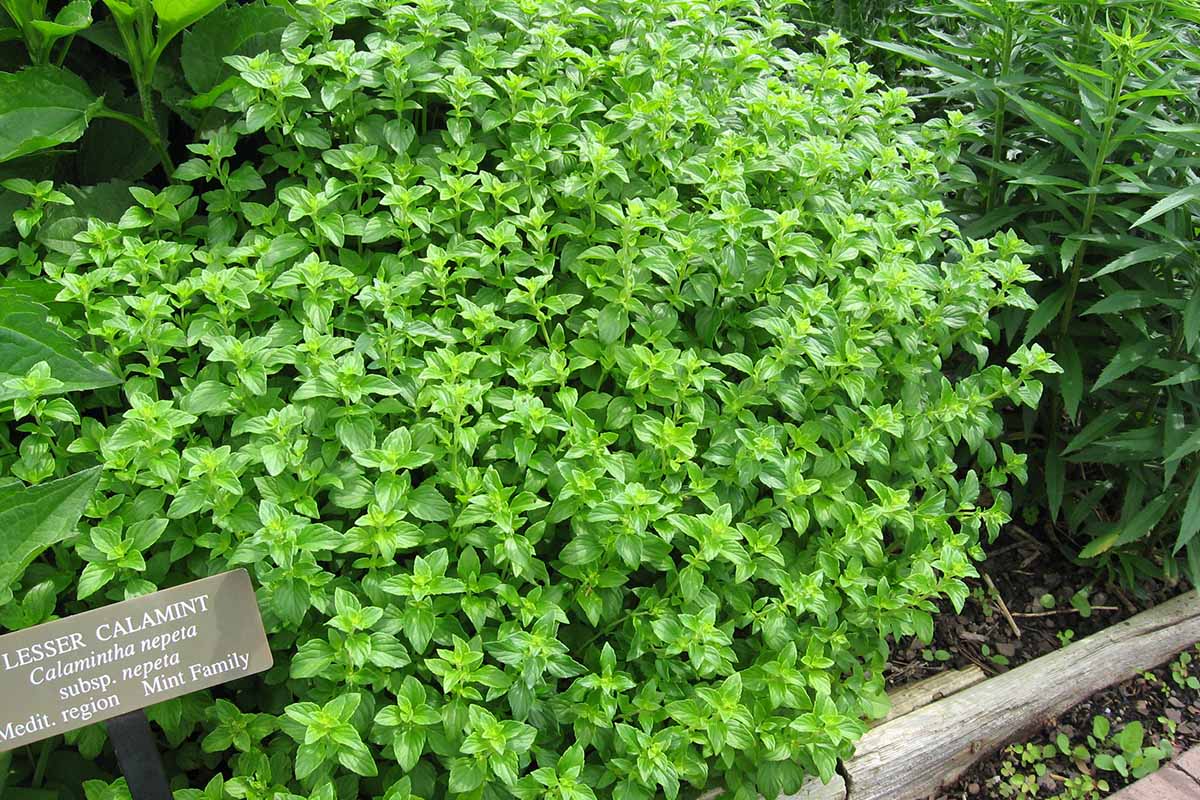
This subspecies was formerly known as its own species, Calamintha nepetoides. It was named perennial of the year by the Perennial Plant Association in 2021.
C. Vulgare
C. vulgare is a plant known by the common name “wild basil.”
This species of Clinopodium has hairy, oval or lance-shaped leaves, and flowers that are pink, lilac, or purple.

Botanists don’t quite agree on which locations this herb should rightfully call home.
Some say its native range spans from North Africa to Siberia, and that it is a naturalized (rather than native) species in the US, while others claim it is indeed native to a large portion of the northeast quadrant of North America.
Whoever is right, wild basil grows beautifully in well-drained loam, sand, rocky, or clay soil, with a pH that is alkaline or neutral.
This plant can be grown as a perennial in USDA Hardiness Zones 5 to 9, in full sun, part shade, or full shade.

Wild Basil Seeds
Ready to grow a crop of wild basil in your herb garden? You’ll find C. vulgare available for purchase in packs of 20 seeds from the Palm Beach Medicinal Herbs Store via Amazon.
Managing Pests and Disease
Calamint is resistant to both deer and rabbits – neither of these occasional garden visitors care much for its strongly scented foliage! And not much in the way of pests or diseases bothers the herb either.
However, keep an eye out for whiteflies, a common garden pest related to aphids and mealybugs.
To prevent problems with whiteflies, focus first on attracting beneficial insects to your garden or yard by planting companion plants and insectary plants.
To treat an existing infestation, be sure to read our article on controlling whiteflies.
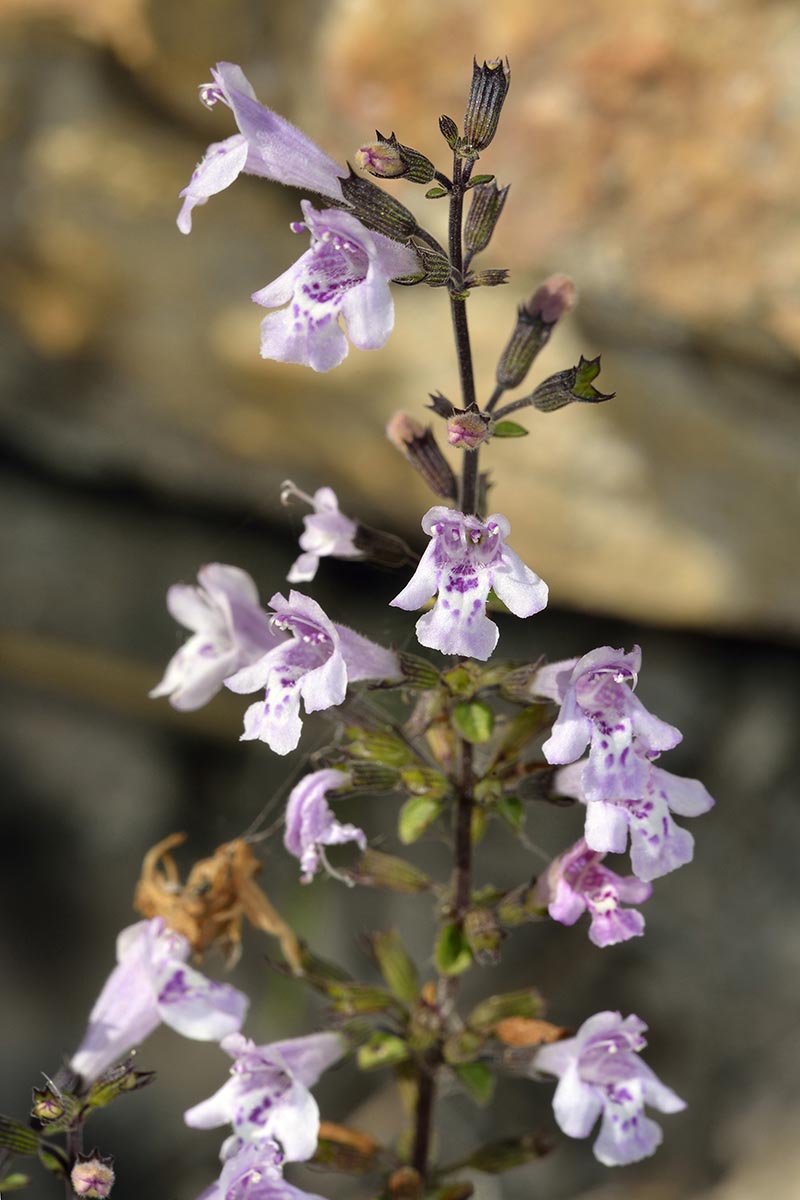
As for diseases, some gardeners report seeing powdery mildew on Clinopodium leaves near the end of the growing season.
If the disease is severe, cut the plant back significantly for a fresh start the next season.
Dispose of infected trimmings not in your compost but in the trash, to avoid contamination of future garden plantings.
Garden Uses
The most obvious use of these plants is to include them when you start an herb garden, but calamint can serve many other purposes in the yard or garden as well.
For instance, you might use it as a foundation plant in your flower beds, or incorporate it into a fragrant garden or cut flower garden.
Some of the low-growing species like C. nepeta or C. alpinum (known as “rock thyme”) can be used as an herbal ground cover. These plants can also be used to form a flowering border or edging along a path or patio, or can be allowed to spill over the edges of rockwork.
These herbs can also be employed as insectary plants in the garden and used to attract pollinators like butterflies and bees.
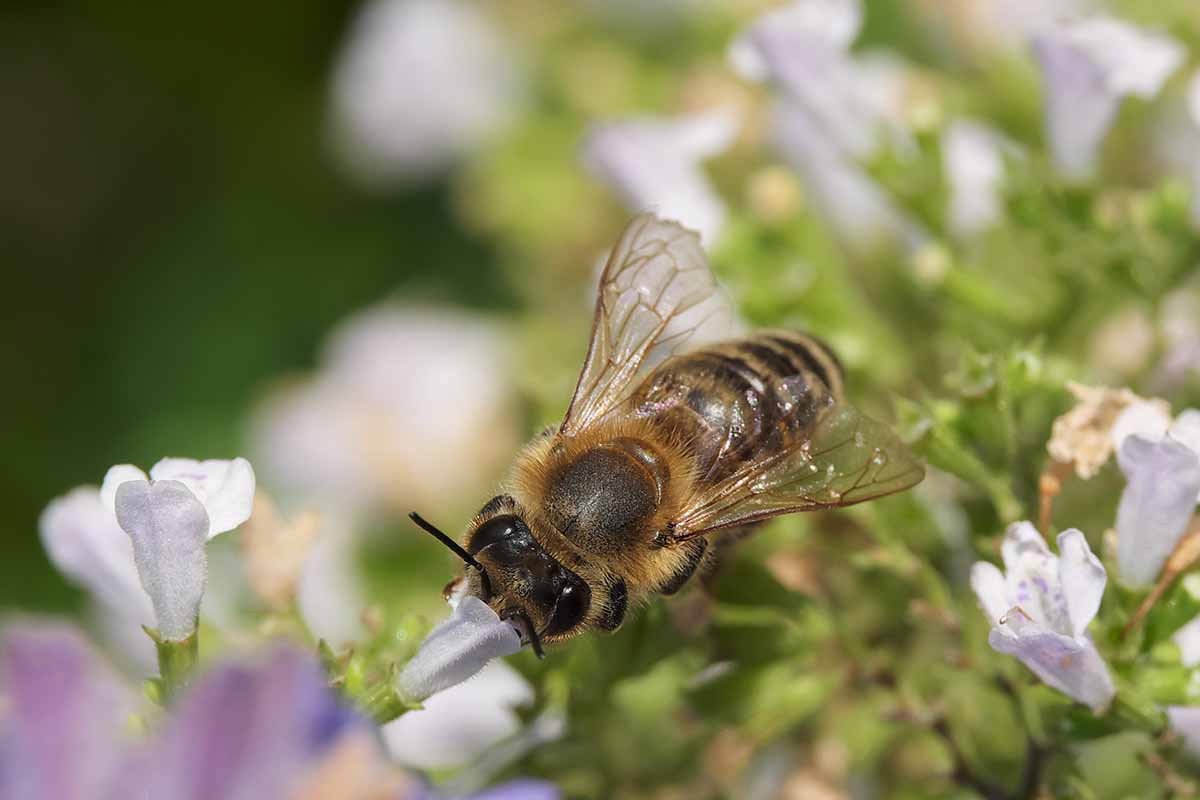
When choosing garden companions for these herbs, consider candidates such as hollyhocks, lavender, purple coneflower, roses, salvia, sage, stonecrop, or yarrow.
From a landscaping design perspective, calamints with white flowers will mix well with pretty much any color scheme.
Types with blue or purple flowers will look smashing with other blue or purple garden blooms, such as purple aster varieties or blue aster cultivars.
Gardeners might also choose complementary colors for the blue and purple blooms of these herbs, such as the orange-blossoms of butterfly weed, a type of milkweed, or the yellow flowers of coreopsis.
Harvesting
This herb can be harvested at any time during the growing season, but some gardeners prefer the taste of the leaves before flowers have bloomed.
Calamint has a potent flavor, so for most culinary creations, you may only need to pluck a few leaves as needed.

However, you may also wish to harvest a larger amount of calamint in order to have a steady supply on hand during the winter.
Take cuttings when the plant is dry, using a clean pair of garden pruners and leaving stems at least six inches long.
Keep in mind that both calamint leaves and flowers are edible, and prepare the herb for preservation soon after harvest.
Preserving
The best way to preserve calamint is through dehydrating, which results in a seasoning much like dried oregano, marjoram, or thyme.
Freshly harvested stems should be rinsed to clean off any dust or insects, and then allowed to dry out.
Get step by step directions for drying fresh garden herbs with our article!
Once the herb is fully dehydrated, remove leaves and flowers from their stems, and place in an airtight container.
Store dried calamint on your spice rack – preferably in a cool location out of direct sun.
Recipes and Cooking Ideas
One of the easiest ways to use calamint is to make a savory herbal tea with it. Just pick a sprig, rinse off, steep for a few minutes in a cup of hot water, and enjoy.
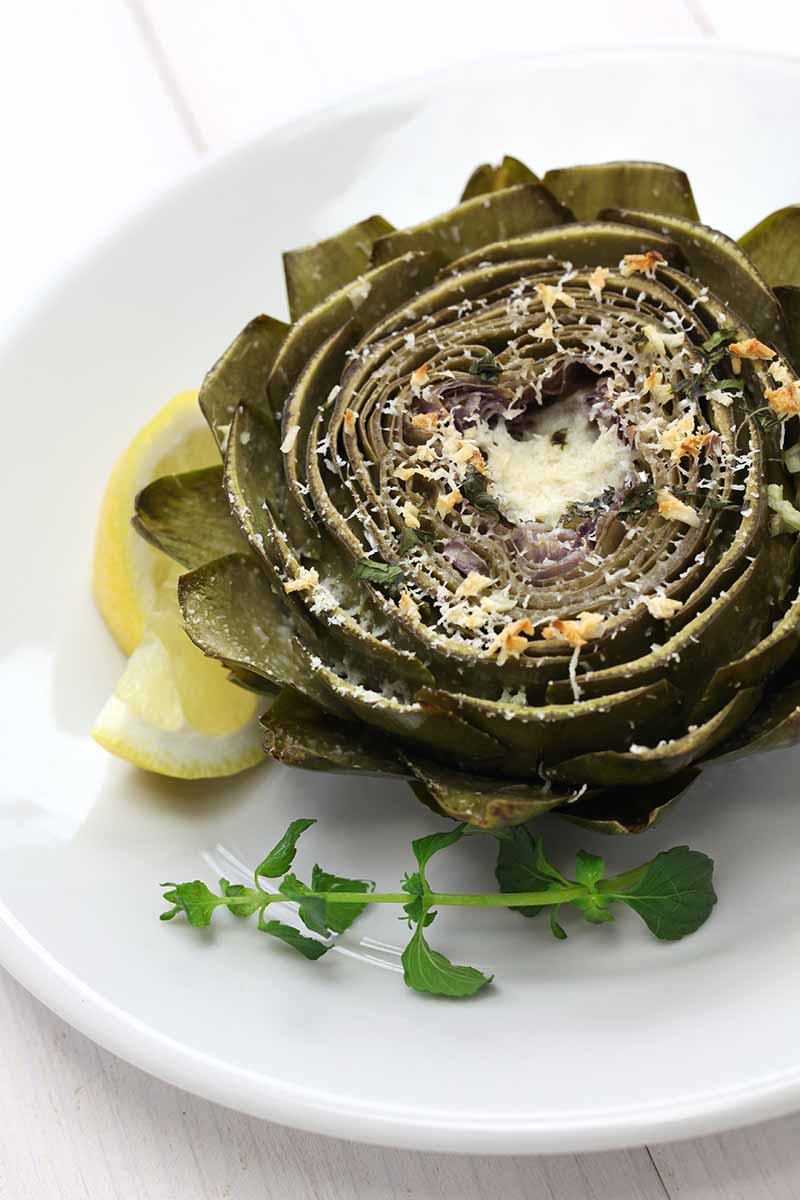
If you’re using calamint in cookery, the type you’re most likely to use is nepitella. This herb pairs well with earthy flavors like eggplant, mushrooms, and artichokes.
Calamint has many traditional uses in Mediterranean cuisine, particularly the different cuisines of Italy.
It’s also sometimes included as an ingredient in the delicious Middle Eastern spice mixture, za’atar.

The New American Herbal
To learn more about this plant’s culinary uses, be sure to read the entry on this herb in “The New American Herbal” by Stephen Orr, available from Amazon.
Quick Reference Growing Guide
| Plant Type: | Small shrub or herbaceous perennial | Flower/Foliage Color: | White, blue, pink, purple, red /grayish-green to green, or green and white |
| Native to: | Africa, Asia, Europe, North America, South America | Tolerance: | Deer, drought, erosion, light frost, rocky soil |
| Hardiness (USDA Zones): | 5-9 | Soil Type: | Clay, loam, rocky, sand |
| Bloom Time/Season: | Spring, summer, fall (depending on the species) | Soil pH: | 6.1-7.3 |
| Exposure: | Full sun, part shade, full shade | Soil Drainage: | Well-draining |
| Time to Maturity: | Varies, depending on species | Attracts: | Bees, butterflies, honey bees, hummingbirds, other pollinators |
| Spacing: | 12-36 inches | Companion Planting: | Cuban oregano, dianthus, hollyhocks, lavender, purple coneflower, roses, salvia, sage, scented geraniums, stonecrop, yarrow |
| Planting Depth: | Soil surface (seed), root ball level with soil surface (transplants) | Uses: | Borders, edging, ground cover, herb gardens, fragrant gardens, insectaries, pollinator gardens |
| Height: | 6-30 inches (depending on variety) | Order: | Lamiales |
| Spread: | 12-36 inches (depending on variety) | Family: | Lamiaceae |
| Water Needs: | Low to moderate | Subfamily: | Nepetoideae |
| Maintenance: | Low | Genus: | Clinopodium |
| Common Pests and Disease: | Whiteflies; powdery mildew | Species: | Ashei, brownei, dentatum, glabellum, grandiflorum, menthifolium, nepeta, vulgare |
Calling All Calamints
If we had to pick a downside to this bushy charmer, it’s that not enough garden stores carry calamint!
We just need to get the word out about this beauty of an herb so more stores will stock it, right?

Tolerant of almost any soil, and offering almost constant summer blooms, aromatic foliage, and purported medical benefits, calamint surely deserves a spot in your landscape.
Are you a fan of this somewhat off-the-radar herb? Do you have any calamint growing in your own yard or garden?
We’d love to learn more about how this interesting plant is performing in your garden. Let us know below in the comments section, and feel free to post photos of your calamints too!
Need more tips for growing an edible herb garden? We have more guidance for you right here:


